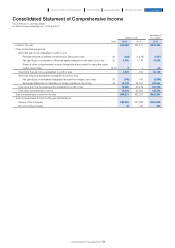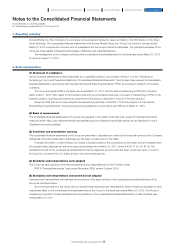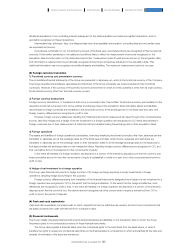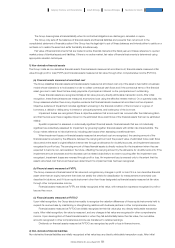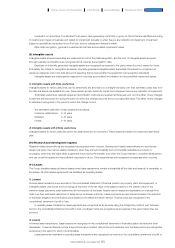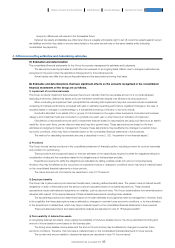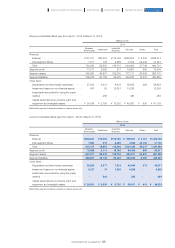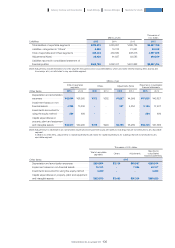Konica Minolta 2015 Annual Report Download - page 95
Download and view the complete annual report
Please find page 95 of the 2015 Konica Minolta annual report below. You can navigate through the pages in the report by either clicking on the pages listed below, or by using the keyword search tool below to find specific information within the annual report.
loss on a straight-line basis over the lease term.
(12) Impairment of non-financial assets
The Group assesses for at each fiscal year-end whether there is any indication that a non-financial asset (excluding inventories,
deferred tax assets and post retirement benefit plan assets) may be impaired. If any such indication exists, then an impairment test
is performed. For goodwill and intangible assets with infinite useful lives or that are not yet in use, an impairment test is performed
each year and whenever there is any indication of impairment.
In an impairment test, the recoverable amount is estimated, and the carrying amount and recoverable amount are compared.
The recoverable amount of an asset, CGU or group of CGUs is determined at the higher of its fair value less costs of disposal or its
value in use. In determining the value in use, estimated future cash flows are discounted to the present value, using pre-tax discount
rates that reflect current market assessments of the time value of money and the risks specific to the asset.
If as the result of the impairment test, the recoverable amount of an asset, CGU or group of CGUs is below its carrying
amount, an impairment loss is recognized. In recognizing impairment losses on CGUs, including goodwill, first the carrying amount
of goodwill allocated to the CGUs is reduced. Next, the carrying amounts of other assets within the CGUs are reduced
proportionally.
If there is any indication that an impairment loss recognized in previous periods may be reversed, the impairment loss is
reversed if the recoverable amount exceeds the carrying amount as a result of estimating the recoverable amount. An impairment
loss is reversed only to the extent that the asset’s carrying amount does not exceed the carrying amount that would have been
determined, net of depreciation or amortization, if no impairment loss had been recognized. Impairment losses on goodwill are not
reversed.
(13) Non-current assets or disposal groups classified as held for sale
For assets or asset groups that are not in continuing use and for which recovery through sale is expected, that are highly likely to be
sold within one year, and that can be quickly sold in their current condition, assets held for sale and liabilities directly related to
assets held for sale are classified as disposal groups in other assets and liabilities and recorded in the consolidated statement of
financial position.
(14) Employee benefits
1) Post-retirement benefits
The Group employs defined benefit plans and defined contribution plans as post-retirement benefit plans for employees.
(a) Defined benefit plans
The Group calculates the present value of the defined benefit obligations, related current service cost and past service cost
using the projected unit credit method.
For a discount rate, a discount period is determined based on the period until the expected date of benefit payment in
each fiscal year, and the discount rate is determined by reference to market yields for the period corresponding to the discount
period at the end of the fiscal year on high-quality corporate bonds.
Assets and liabilities related to the post-retirement benefit plans are calculated by the present value of the defined benefit
obligation, deducting the fair value of any plan assets, and their amounts are recognized in the consolidated statement of
financial position. The net amount of interest income related to plan assets in the post-retirement benefit plans, interest costs
related to defined benefit obligation, and current service cost is recognized as profit or loss.
Differences arising from remeasurements of defined benefit plans are recognized in full in OCI in the period when they are
incurred and transferred to retained earnings immediately. The entire amount of past service costs is recognized as profit or loss
in the period when incurred.
(b) Defined contribution plans
The cost for defined-contribution post-retirement benefit plans is recognized as an expense at the time of contribution.
2) Short-term employee benefits
Short-term employee benefits are not discounted, but are recognized as expenses when related services are provided.
If the Group has a present legal or constructive obligation to pay bonuses and paid vacation expenses and the obligation can
be estimated reliably, a liability is recognized for the estimated payment amounts.
(15) Share-based payments
The Group has in place for directors (excluding outside directors) and officers of the Company a share option plan as an equity-
settled share-based payment plan. Share options are estimated at fair value at grant date and are recognized as an expense over
94
KONICA MINOLTA, INC. Annual Report 2015
Foundation for GrowthBusiness StrategiesGrowth StrategyCompany Overview and Characteristics Financial Report


